Victorian homes had high ceilings as a hallmark of elegance and functionality. These lofty spaces emphasized grandeur, creating an impression of wealth and social status. The architecture favored tall ceilings for better air circulation and natural light, making homes more comfortable and inviting. Additionally, high ceilings helped improve indoor air quality by dissipating smoke from candles and lamps. This design trend reflected the era's blend of luxury and practicality. If you're curious about how these historical elements affect modern real estate preferences and values, there's more to uncover on this fascinating topic.
Key Takeaways
- High ceilings in Victorian homes emphasized grandeur and spaciousness, reflecting the affluence of the era's architectural styles.
- Elevated ceilings improved air circulation and indoor comfort, aligning with health beliefs about living conditions during that time.
- Ornate decorations on high ceilings showcased craftsmanship and added aesthetic appeal, enhancing the home's visual drama.
- The design allowed for larger furniture and enhanced natural light through tall windows, creating inviting atmospheres.
- Today, high ceilings continue to be a desirable feature, influencing property value and buyer preferences in the real estate market.
Historical Context of Ceiling Heights

As you explore the historical context of ceiling heights, you'll find that during the Victorian era, homes boasted impressive ceiling heights averaging around 13 feet. This preference for high ceilings reflected architectural trends that emphasized spaciousness and grandeur.
Victorians embraced these tall spaces not just for aesthetics but also for practical reasons, enhancing air circulation and improving ventilation during warmer months. The elaborate ceiling designs characteristic of Gothic Revival and Queen Anne styles contributed to the opulence of these homes, showcasing the era's craftsmanship.
By contrast, the post-World War II housing boom shifted towards standardized eight-foot ceilings, marking a significant departure from the Victorian ideals.
Today, historical preservation movements have reignited interest in these magnificent high ceilings, celebrating their lasting beauty and significance.
Practical Reasons for High Ceilings
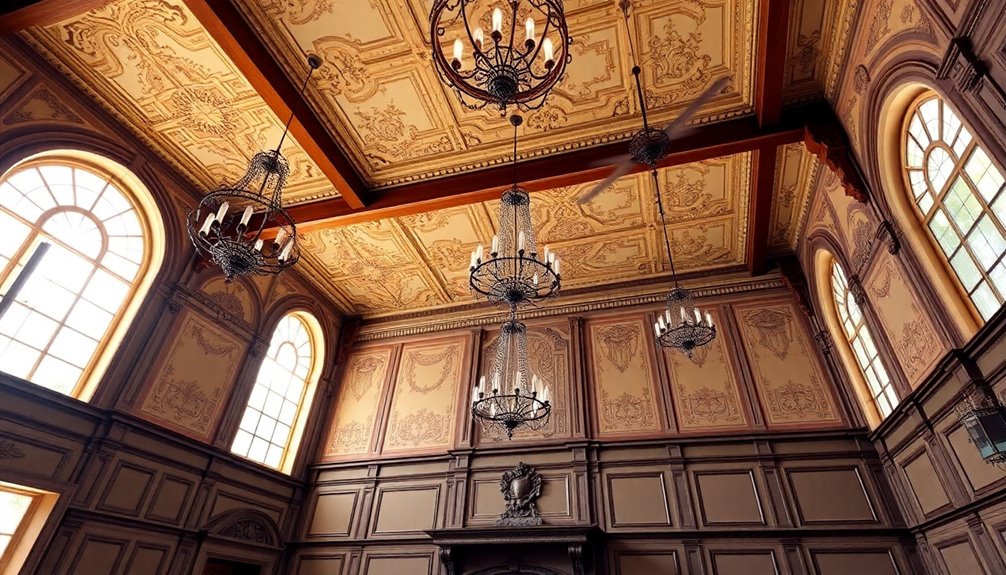
When you step into a Victorian home with high ceilings, you'll notice the immediate benefits of improved air circulation and enhanced natural light.
These lofty spaces not only help cool the rooms by allowing hot air to rise but also bring in more sunlight, creating a warm and inviting atmosphere.
This design choice reflects both practicality and the luxurious aesthetic of the era.
Improved Air Circulation
High ceilings in Victorian homes aren't just a design feature; they play an essential role in improving air circulation.
These elevated spaces allow warm air to rise, enabling cool air to flow in from lower levels, which creates a more comfortable living environment.
This design also helps dissipate smoke from candles and oil lamps, enhancing indoor air quality during a time when open flames were common.
In warmer climates, the extra height contributes to natural ventilation, keeping spaces cooler without relying heavily on mechanical cooling systems.
Additionally,
Enhanced Natural Light
While many admire the elegance of Victorian homes, the practical benefits of high ceilings, particularly in enhancing natural light, are equally remarkable.
The design of these homes featured tall windows that stretched to the ceiling, allowing sunlight to flood in and create inviting spaces. This arrangement not only maximized daylight but also improved ventilation, making for a comfortable living environment, especially in warmer areas.
The combination of high ceilings and large windows made rooms feel more spacious and open, enhancing the overall aesthetic appeal. Additionally, the enhanced natural light contributed to your health and well-being by reducing the need for artificial lighting during the day.
This thoughtful architectural choice reflects the Victorian commitment to both beauty and functionality.
Aesthetic Appeal of Elevated Spaces
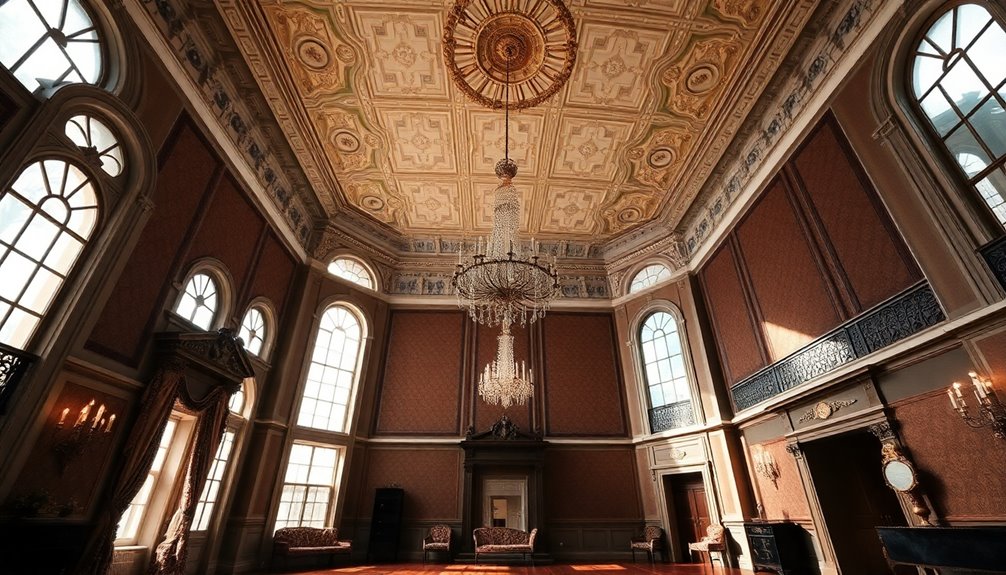
The allure of elevated spaces captivates many, as the soaring ceilings of Victorian homes evoke a sense of grandeur and elegance. With ceiling heights averaging 13 feet, these homes create an impressive atmosphere that's hard to ignore.
High ceilings allow for intricate architectural details, like ornate cornices and elaborate plasterwork, enhancing the visual drama of your surroundings. This openness fosters an airy feel, setting Victorian homes apart from earlier, more compact designs.
The spaciousness also accommodates large windows, flooding the interiors with natural light and emphasizing the home's sophistication. Ultimately, the aesthetic appeal of high ceilings reflects the cultural values of the era, where opulence and spaciousness symbolized social status and wealth. Additionally, the architectural design of these homes often included features that promote energy efficiency, aligning with modern sustainable practices.
Modern Ceiling Height Trends
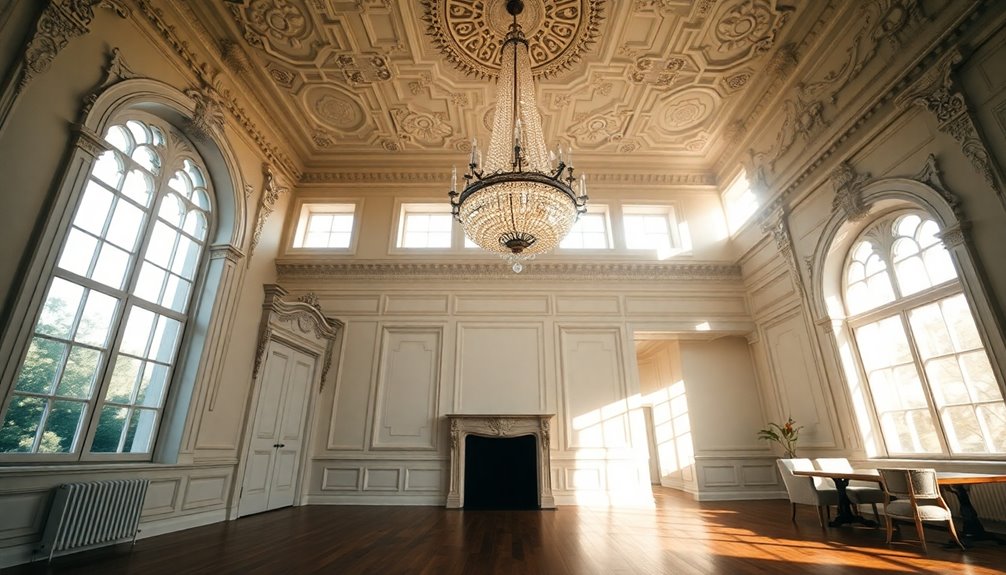
As homeowners increasingly seek spaciousness and comfort, modern ceiling height trends reflect a shift towards more open interiors.
The average ceiling height in new homes today has risen to around nine feet on the first floor, surpassing the traditional eight-foot standard. Suburban developments have embraced this change over the past decade, enhancing the feeling of space throughout.
Custom homes often feature ten-foot ceilings, catering to your desire for luxurious living environments. The late 20th century's "McMansion" trend popularized two-story family rooms with higher ceilings, further driving demand for these features in modern construction.
Even commercial spaces, like the New York Times Building, showcase ceilings up to 11 feet, emphasizing the current preference for expansive work environments and airy living spaces. In addition, the integration of advanced insulation materials in modern designs contributes to maintaining comfortable temperatures, enhancing the overall living experience.
Benefits of High Ceilings
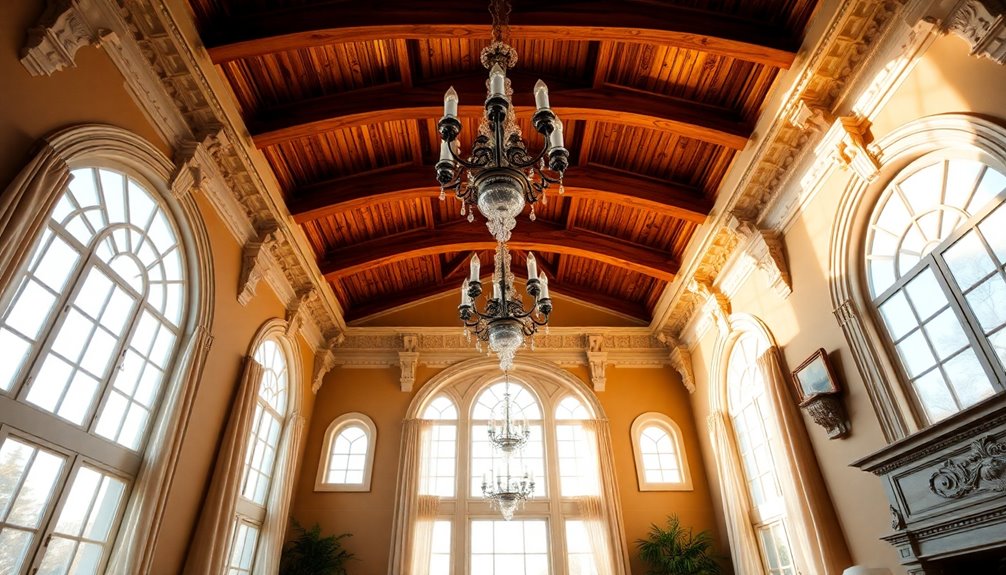
High ceilings offer a variety of benefits that enhance both comfort and aesthetics in your home.
In older buildings, like Victorian homes, these lofty ceilings improve air circulation, keeping your living space cooler in warm climates.
The spacious feeling high ceilings provide makes interiors appear more luxurious and grand, elevating your home's overall appeal.
Larger windows can be installed, flooding your rooms with natural light and creating an inviting atmosphere.
Additionally, the acoustics in spaces with high ceilings are better, reducing noise transfer between floors.
Finally, the grandeur of high ceilings acts as a status symbol, reflecting the wealth and social standing of homeowners during the Victorian era, which can still add character and charm to your living space today.
Economic Impact of Ceiling Heights
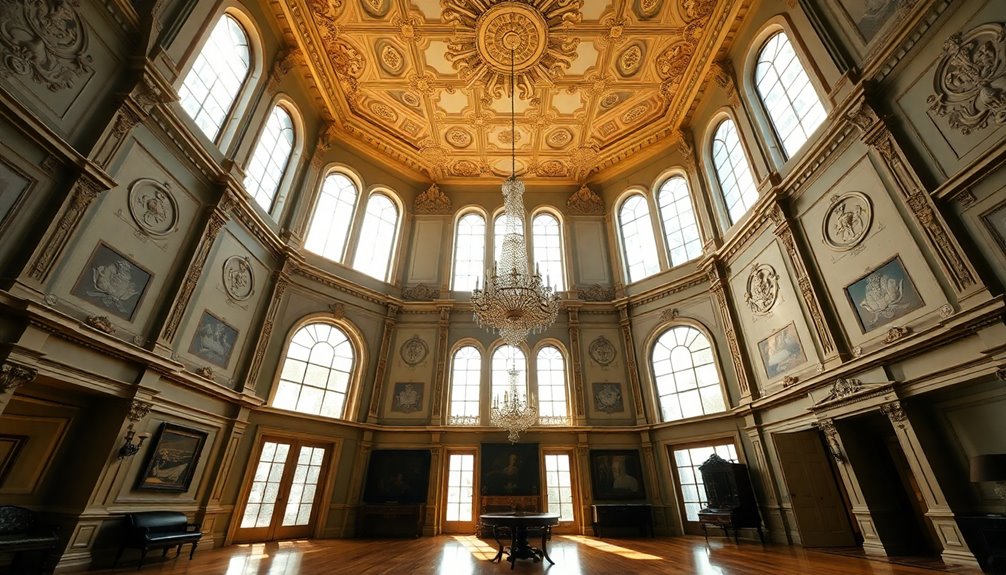
When you consider the economic impact of ceiling heights in Victorian homes, you'll notice construction costs can increase considerably.
Higher ceilings not only enhance the aesthetic appeal but also boost property value, making them a desirable feature for buyers.
This demand creates a ripple effect, influencing market trends and investment returns in real estate.
Construction Cost Considerations
Victorian homes with high ceilings come with significant construction costs that can range from $20,000 to $30,000 for a 4,000-square-foot house. The desire for grandeur and spaciousness drives these expenses up.
Higher ceilings require larger furniture and taller windows, adding to the overall design and material costs. While the initial investment is substantial, you might find some cost savings in improved insulation and energy-efficient windows that offset these construction costs.
Economic factors, like the demand for luxury features and the status associated with high ceilings, encouraged builders to prioritize taller structures despite the financial implications.
Over time, shifting design preferences and economic considerations led to more cost-effective housing solutions with lower ceilings post-World War II.
Investment Value Increase
Investing in a home with high ceilings can greatly boost its market value. Higher ceilings aren't just an aesthetic choice; they symbolize luxury and status, attracting affluent buyers willing to pay a premium.
The average cost to build homes with taller ceilings can range from $20,000 to $30,000 for a standard 4,000-square-foot house, reflecting significant investment value. Properties featuring high ceilings often create an illusion of spaciousness, making them more appealing to modern homebuyers.
Economic trends show that homes with higher ceilings command higher asking prices, as they're linked to luxury features in contemporary architecture. Moreover, the historical preservation movement has increased the investment value of Victorian homes, as enthusiasts seek properties with original high ceilings. Additionally, understanding estate planning can help homeowners maximize their property's value and ensure assets are effectively managed.
Market Demand Influence
While many factors influence market demand, ceiling heights play an essential role in determining property value, particularly in Victorian homes. High ceilings aren't just aesthetically pleasing; they greatly impact buyers' preferences.
Here are a few reasons why:
- Luxury Appeal: High ceilings are associated with opulence, attracting affluent buyers.
- Natural Light: Taller ceilings allow for larger windows, enhancing light and ventilation.
- Investment Value: The initial construction cost is often offset by increased property value.
- Changing Trends: The Victorian era shifted toward ornate designs, solidifying the demand for spacious interiors.
These elements create a lasting influence on market demand, ensuring that properties with high ceilings continue to fetch premium prices today.
Cultural Influences on Ceiling Design
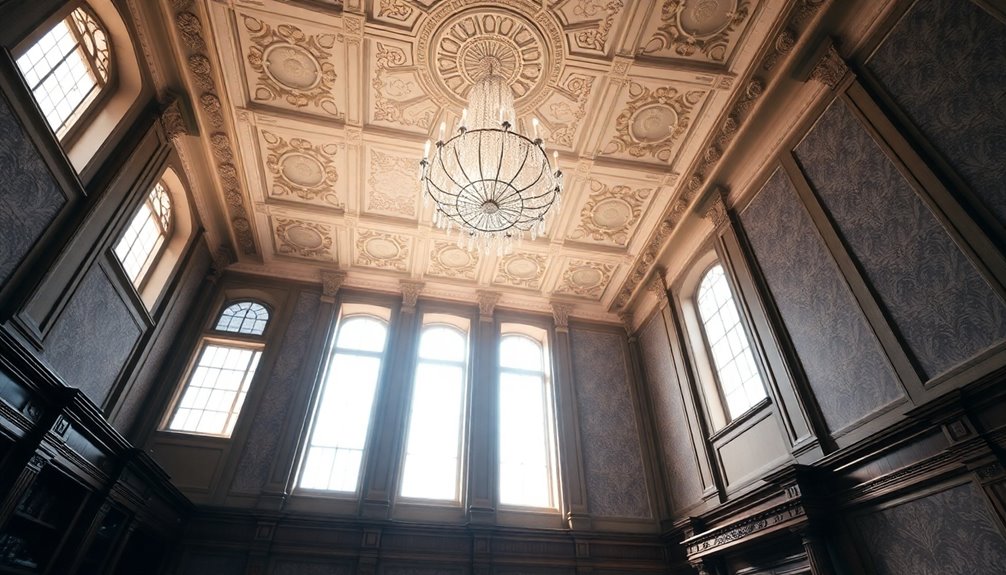
As architectural trends evolved during the Industrial Revolution, high ceilings became a hallmark of Victorian homes, reflecting both cultural aspirations and practical considerations.
The era's emphasis on grandeur and opulence influenced designers to create spacious interiors that symbolized wealth and status. Homeowners proudly showcased their affluence through elevated ceilings adorned with intricate decorations.
Additionally, high ceilings served practical purposes, promoting better ventilation and air circulation, aligning with health beliefs of the time. This focus on comfort and aesthetics led to the enduring popularity of high ceilings in Victorian architecture.
Today, many homeowners seek these features to evoke a sense of history and luxury, proving that the cultural influences of the past still resonate in modern design.
Frequently Asked Questions
Why Did Victorian Houses Have High Ceilings?
Victorian houses had high ceilings for several reasons.
You'll notice that these elevated spaces symbolize wealth and grandeur, creating a sense of openness. They improved air circulation, making homes more comfortable, especially with fireplaces for heating.
Plus, larger windows allowed for more natural light, enhancing the atmosphere.
The architectural techniques of the time, like balloon framing, supported these heights, while intricate moldings added an artistic touch to the overall design.
Why Did They Build Houses With High Ceilings?
When you think about why they built houses with high ceilings, consider airiness and elegance.
High ceilings enhance air circulation, create spaciousness, and invite natural light. They also symbolize wealth and power, showcasing the homeowner's status.
By allowing larger windows, these ceilings improve ventilation and brightness.
Ultimately, they transform a simple space into a grand statement, reflecting the architectural trends and cultural desires of the time.
You can't help but admire their beauty!
What Was the Ceiling Height of a Victorian House?
In Victorian homes, the ceiling height typically ranged from 10 to 13 feet.
You'd notice this grandeur as soon as you walked in, creating a spacious and airy feel.
These high ceilings not only enhanced the aesthetic appeal but also allowed for better ventilation, making the home more comfortable.
If you appreciate historical architecture, you'll find that these lofty ceilings symbolize the wealth and sophistication of the era, adding to their charm.
What Is the Purpose of High Ceilings?
High ceilings serve multiple purposes in a home. They improve air circulation, keeping your space cooler and reducing smoke buildup from fires or candles.
The added vertical height creates an illusion of spaciousness, making rooms feel more luxurious. You'll also enjoy larger windows, which bring in more natural light and enhance ventilation.
Plus, high ceilings can elevate your home's aesthetic appeal, showcasing intricate designs and reflecting a sense of grandeur.
Conclusion
In the end, high ceilings in Victorian homes aren't just relics of the past; they're like echoes of a time when elegance and practicality danced together. You can see how these elevated spaces breathed life into rooms, creating an atmosphere of grandeur and comfort. Today, while trends shift, the allure of those soaring heights remains, reminding us that sometimes, it's the lofty aspirations of design that elevate our everyday experiences. So, why not reach for the sky?









